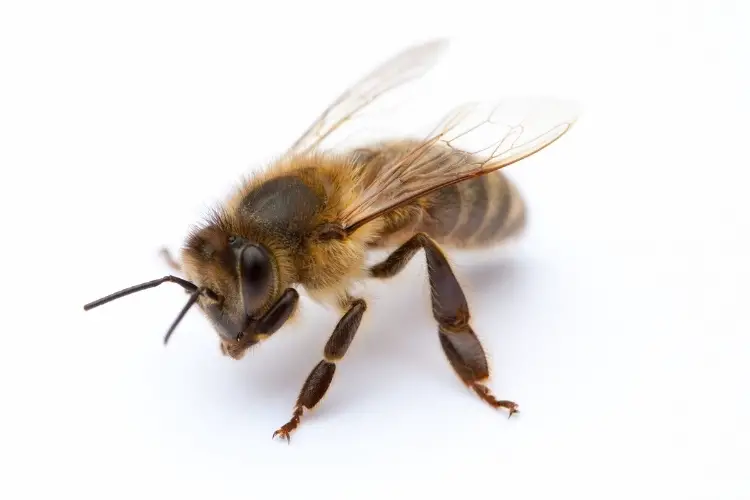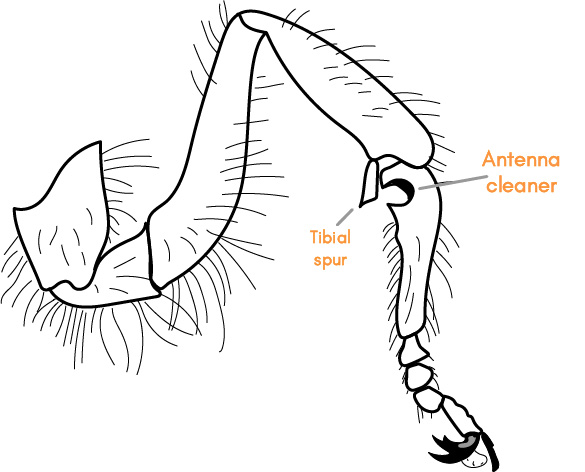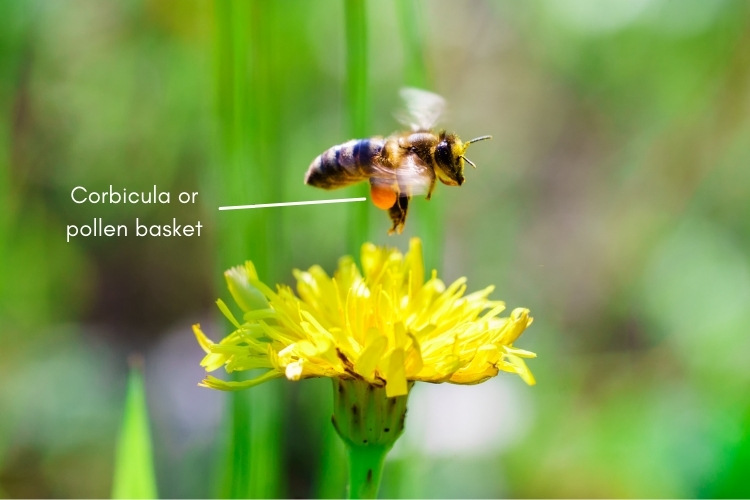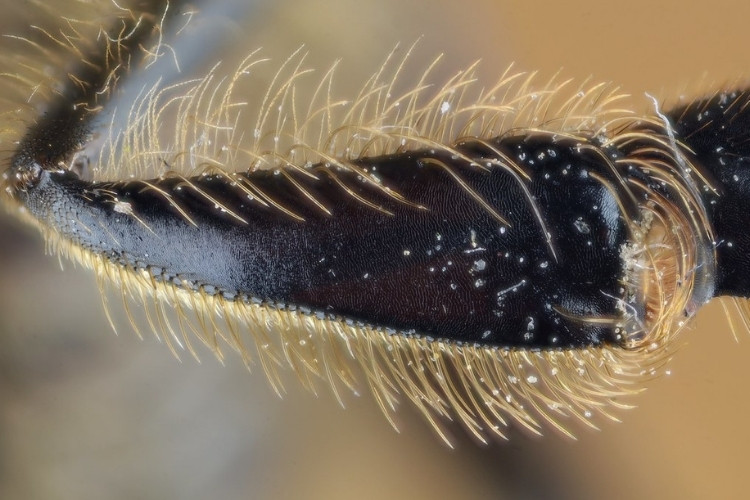Honey bees have 6 legs or 3 pairs of legs attached to their thorax. Bees’ legs are segmented into coxa, trochanter, femur, tibia, tarsus (which contains the basitarsus and 3 tarsomeres), and the pretarsus.
Bees use their legs for a variety of tasks besides walking. Some of these additional functions include grooming and cleaning themselves as well as collecting and storing pollen.
The 3 sets of legs share the same basic structure, but some contain a few adaptations to perform specific tasks. For example, the antenna cleaner on the front legs and the corbicula on the hind legs.
Among castes, legs can differ in the shape of specific segments mostly related to their particular role in the colony, like collecting pollen.

Legs Segments And Parts
Bees’ legs are segmented into the following parts:
Coxa – This is where the leg is attached to the thorax and allows the legs to move forward and backward.
Trochanter – found between the coxa and the femur. The trochanter allows the leg’s upwards and downwards movement and moves as a unit with the femur.
Following the femur is the tibia, which points downwards from the femur.
Tibia – is one of the segments that shows the most notable differences between the front, middle and hind leg.
This segment contains some adaptations that allow bees to perform specific tasks. More on that later.
Following the tibia is the tarsus, which divides into 5 subsegments known as tarsomeres.
Unlike the tibia and the previous segments, the tarsus doesn’t have muscles. Instead, a long tendon known as the unguitractor tendon runs through the leg, including the tarsomeres.

The first of the tarsomeres is called the basitarsus and is the largest.
The basitarsus is followed by three smaller tarsomeres and the pretarsus ending with the foot.
The pretarsus comprises the last of the tarsomeres and the foot. The foot, as you can imagine, helps bees land on surfaces. This segment also contains two pairs of claws and the arolium.
The arolium is a smooth and flexible pad between the claws and allows bees to adhere to surfaces.
The claws can provide a strong foothold; however, they are not always sufficient to provide stability, like when bees land on slippery or smooth materials.
This is where the arolium comes in. The arolium allows bees to literally stick to the surface by secreting a glue-like substance.
Do Bees Have Knees?
You might have heard the popular expression “the bee’s knees,” used to state something as exceptional or of high quality. If so, does it make you wonder if bees really have knees?
Turns out they do!
Like humans, bees have a tibia and a femur in their legs attached together by a joint. In general terms, this joint is what we commonly know in human anatomy as the knee joint.
Therefore, the joint between bees’ tibia and femur could be thought of as the knee.
As for why they’re an expression of exceptional quality… Maybe it is a topic for a future article 😉.
What Do Bees Use Their Legs For?
Bees use their legs for many things. Some of these are expected, like walking and landing after flying; however, there are other ways they use their legs that assist them in everyday activities like collecting pollen.
Not All Legs Are Made Equal
Each set of legs helps bees in particular tasks. Because of this, they have some physiological differences.
Front Legs or Forelegs
Because of their proximity to the head, the front legs groom and clean the mouth and antennas.
The front legs have a specific part that allows them to do this job better. This part is called the antenna cleaner, and it’s located between the tibia and the basitarsus.
The antenna cleaner looks like a sickle or semicircle cavity on the basitarsus and includes a row of stiff hairs. Additionally, a spur or spike, called the tibial spur attached to the tibia, closes into the indentation when the basitarsus is bent towards the tibia.

Bees use the antenna cleaner by placing the antenna into the nook and bending the leg so the spur closes over the antennae and a row of bristles traps any pollen particles or dust.
Middle Legs
The middle legs don’t have any unique parts or a specific task that sets them apart from the other two.
They seem to assist both the fore and hind legs in grooming and collecting pollen which makes sense since they are in-between.
Hindlegs
The most known task for the hindlegs is their ability to collect and carry pollen. Maybe while observing bees, you have noticed something that looks like a yellow bulb attached to their hindlegs.

These are their pollen baskets, which can be noticeable once they are full.
You can probably see them if you pay attention and get close enough (only if you feel confident of doing so and aren’t allergic).
This particular adaptation is located on the tibia of worker honey bees, and It’s probably the most evident difference in the legs of the three main castes of bees.
The outer surface of the tibia in worker bees is covered by large, curved hairs that make up a pocket or basket called corbicula.

When worker bees are foraging, pollen gets stuck on the hair covering their bodies.
Bees use the short and stiff bristles on the inner surface of the basitarsus to brush the pollen off the opposite leg and scrape it into the basket.
The hindlegs also have a role in the process of making wax.
Between the basitarsus and the tibia, bees have spines or stiff hairs that scrape the wax when it comes out of the wax glands located on the bottom of their abdomen.
The legs also help transport the fresh wax sheets to their mandibles so they can chew and add salivary secretions to turn it into the substance they use to build the comb in their hive.
I’ve written a whole article about how bees make wax if you’d like to learn more about this interesting topic.
Fun Fact: Bees Can Taste Through Their Feet!
Ok, they actually don’t have taste buds in their legs (or anywhere in their body). But they have taste receptor cells on their front legs and feet, which allow them to process taste.
These receptor cells can be found on the sensilla, special structures in the cuticula that can take the form of hairs or pegs.
Other body parts that have sensilla are the mouth and the antenna.
The sensilla on the forelegs are mostly hair-like and are distributed evenly along the different tarsal subsegments. However, the claw or foot has a higher concentration of these taste receptors.
Final Thoughts
Bee’s have 3 pairs of legs that allow them to do many things other than walking. With their legs, bees can gather and carry pollen to their hive, clean their antenna and mouthparts effectively, and even taste!
All their legs have the same segments, but some of these segments contain special adaptations which help them perform these important tasks.
If you would like to find out more about honey bees’ bodies, you can read my article about bees’ eyes.
Click here to read this article in Spanish.
